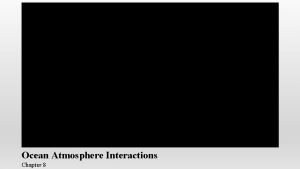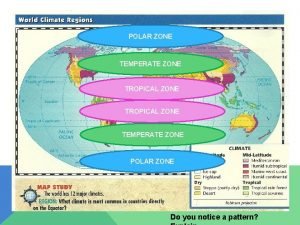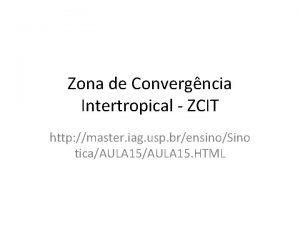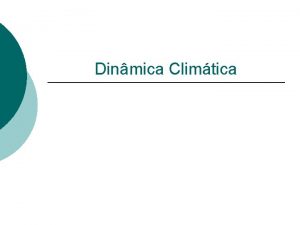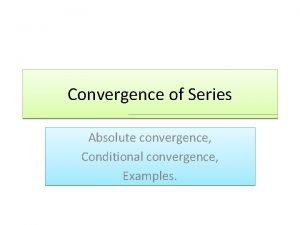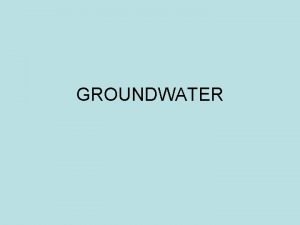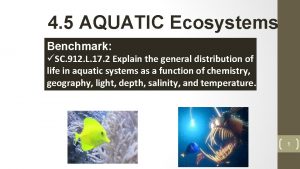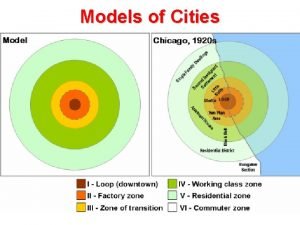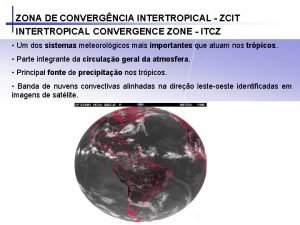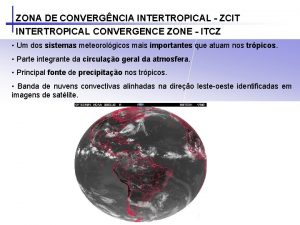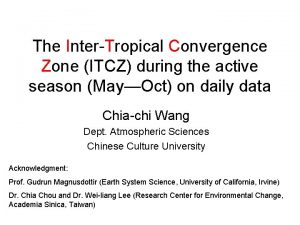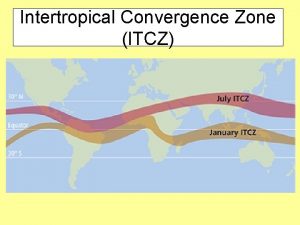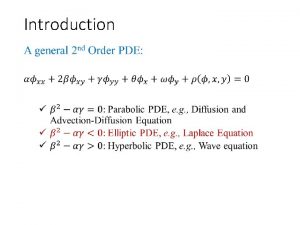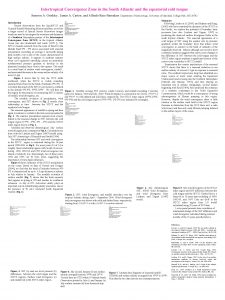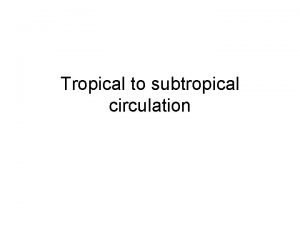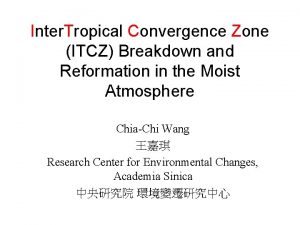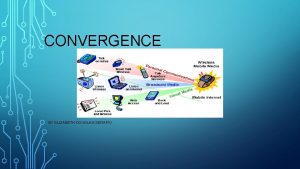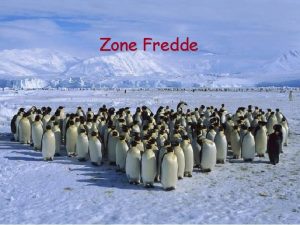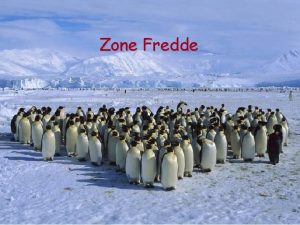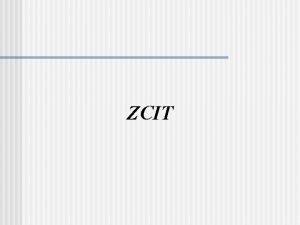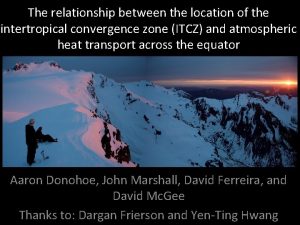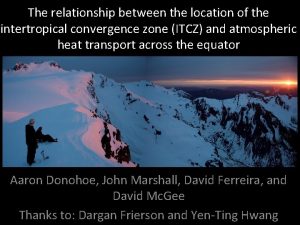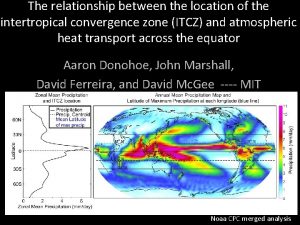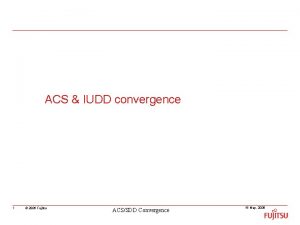An introduction to the Intertropical Convergence Zone ITCZ



























- Slides: 27

An introduction to the Inter-tropical Convergence Zone (ITCZ) Chia-chi Wang Dept. Atmospheric Sciences Chinese Culture University Acknowledgment: Prof. Gudrun Magnusdottir Earth system science University of California, Irvine



ITCZ Visible Channel (~0. 65 um)


Scale of different weather systems

Idealized simulations of Hadley cells Northern hemisphere Summer pressure Spring or fall Contour: streamfunction Strong cell in the winter hemisphere

Climatological uflow v Zonal and time average of the wind field from the high resolution NCEP analysis from Aug —Oct, 2000— 2002.

Climatological ITCZ Waliser and Gautier 1993. Averaged from 17 years of monthly Highly reflective cloud (HRC) data. The number of days per month the given grid point was covered by a largescale deep convective system, subjectively determined.

The shallow meridional circulation A return flow atop the atmospheric boundary layer (ABL), around 2 -4 km, in the winter hemisphere (Zhang et al. 2004)

Aug. -Dec. , 1995 -2002, 95 W-110 W Altitude (km) 1 -11 Nov. 2000, 95 W Altitude (km) Meridional wind & RH (Tropical Atmosphere-Ocean (TAO) ship soundings) (Zhang et al. 2004) Latitude

Satellite images of the shallow ITCZ (20 Sept 2000) VS IR

Some interesting topics • • • ITCZ tends to stay in the NH. Double ITCZ in the eastern Pacific South Pacific Convergence Zone (SPCZ) East Pacific ITCZ and cold tongue complex ITCZ breakdown Equatorial waves (Rossby waves and Kelvin waves) v. s. ENSO • West-ward propagating disturbances (ex. Easterly waves) • Madden-Julian Oscillation (MJO) • Mesoscale processes related to cloud clusters

ITCZ breakdown

1988, IR Another case of ITCZ breakdown

Why is it important? • To understand the basic dynamics of the ITCZ on synoptic timescale. • An efficient way to pool vorticity in regions in the tropics which represents the early stages of tropical cyclonegenesis. • Might contribute meridional moisture transport (need more data and study). • It is an interesting topic.

Horizontal heating profile Vortex roll-up simulation Vertical heating profile Wang and Magnusdottir (2005)

Relative vorticity ζ - +

Potential vorticity (PV) Planetary vorticity, f SP EQ PV = ( f + ζ) / h PV is conserved when there is no friction and no diabatic heating. NP

Idealized simulation of ITCZ breakdown Potential Vorticity ~850 h. Pa PVU Barotropic instability (strong horizontal wind shear) Wang and Magnusdottir (2005)

Characteristics of the ITCZ on synoptic timescale: • The breakdown can be self-induced • The new ITCZ re-forms within a few days A strong mode of synoptic timescale lifecycle

North Eastern Pacific Phase speed = 8 m/s Longwave approximation: Non-dispersive waves u = 2. 6 m/s easterly u = 0 m/s Dispersion curve for equatorial Rossby waves (n = 1) Magnusdottir and Wang 2008

ITCZ composite (lag-regression between the raw vorticity data and the ITCZ index) Magnusdottir and Wang 2008

Summary • The ITCZ goes through stages of formation, undulation, breakdown, and dissipation on synoptic timescale. • The ITCZ is a constructive feature. It is not a group of thermal-driven convective cells lined up in a row. • A non-dispersive wave packet propagates westward in a constant phase speed.

Future work • Its vertical structure needs more study. • Wet convection in model simulation • The interaction with other phenomena (on other timescales) such as MJO and ENSO. • Mechanisms to form the ITCZ in details?

Magnusdottir and Wang 2008 25 -day running variance of the filtered vorticity El Nino La Nina El Nino

An elongated convergent area induced by a weak disturbance Wang et al. 2010
 Itcz
Itcz Which countries are in the temperate zone
Which countries are in the temperate zone Intertidal ocean zone
Intertidal ocean zone Source zone transition zone and floodplain zone
Source zone transition zone and floodplain zone Iag master
Iag master Tipos de clima laboral
Tipos de clima laboral Zona intertropical
Zona intertropical Convergência intertropical
Convergência intertropical Igneas
Igneas If the absolute value of a series converges
If the absolute value of a series converges Zone de convergence
Zone de convergence Respiratory system zones
Respiratory system zones Respiratory zone
Respiratory zone Zone chaude et froide magasin
Zone chaude et froide magasin Water table chart
Water table chart Underground water table
Underground water table Latitude climate
Latitude climate Photic zone and aphotic zone venn diagram
Photic zone and aphotic zone venn diagram Normal minute ventilation
Normal minute ventilation Zone 1 and zone 2
Zone 1 and zone 2 Hoyt model
Hoyt model Hình ảnh bộ gõ cơ thể búng tay
Hình ảnh bộ gõ cơ thể búng tay Ng-html
Ng-html Bổ thể
Bổ thể Tỉ lệ cơ thể trẻ em
Tỉ lệ cơ thể trẻ em Chó sói
Chó sói Tư thế worm breton
Tư thế worm breton Chúa sống lại
Chúa sống lại
